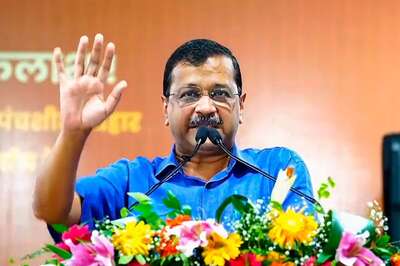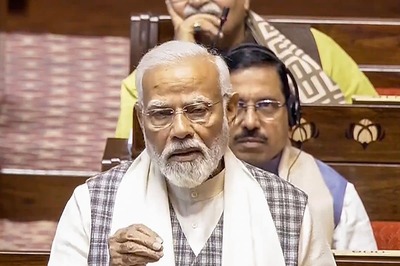
views
A recent order of a three-judge Bench of the Supreme Court has reignited the debate on the Sutlej-Yamnua Link (SYL) Canal that involves the transfer of river water to Haryana, a constituent part of Punjab until 1966. The Bench chaired by Justice Sanjay Kisan Kaul ordered the Centre to conduct a survey in Punjab, to ascertain how much work has been done and has asked the state government to extend full cooperation.
Punjab Chief Minister Bhagwant Mann has opposed the Order, claiming the state has not a drop of ‘surplus’ water to spare. He would surely be found in good company. A former chief minister of Punjab, and his son who was deputy chief minister, had gone under the gavel for openly claiming in 2016 that they would not allow the Supreme Court’s verdict on SYL Canal (and actually de-notified major chunk of the acquired land in four districts). The contempt proceedings against them were closed only last year, when a bench led by Justice Sanjay Kaul on September 7, 2002, referred the matter for a mediated settlement.
SYL is an issue that divides the political class on provincial rather than political lines. Whereas in Punjab, all political parties would oppose the SYL Canal, in Haryana, they would be found supporting the project.
On July 12, 2004, when Capt Amarinder Singh (Retd) was the chief minister, the state enacted the Punjab Termination of Agreements Act, 2004. It terminated and discharged the Punjab government from its obligations under the agreement dated December 31, 1981, and other agreements on sharing waters of Ravi-Beas. During Prakash Singh Badal’s last term as Chief Minister, the Punjab Legislative Assembly passed the Punjab Sutlej Yamuna Link Canal Land (Transfer of Propriety Rights) Bill, 2016 to de-notify the land acquired for the purpose of SYL Canal. Albeit passed by the Punjab Legislative Assembly, it remains a Bill as no Governor has given his assent to it.
The matter went up to the Supreme Court, which on March 17, 2016, directed that the status quo should be maintained by the parties with regard to lands, works, property and portions of SYL Canal and all lands within the alignment of SYL Canal within the territories of Punjab, covered by earlier judgments of the Supreme Court. However, almost 90 per cent of the land (4,627 acres out of 5,376 acres) acquired between 1977 and 1982 in four districts of Rupnagar, Mohali, Patiala and Fatehgarh Sahib was handed back to the farmers by using quasi-judicial powers. The matter escalated into contempt proceedings in the Supreme Court.
II
What puts Punjab at the centre of a water war? As the Indus Water Treaty, 1960 was on the anvil, it was a foregone conclusion that Pakistan would be the sole riparian for the Western rivers viz. Indus, Chenab, Jhelum as far as water for agriculture and hydroelectricity was concerned. Similarly, India will get the lion’s share of waters of Eastern rivers like Sutlej, Ravi and Beas until they naturally flow into Pakistan’s territory. All the rivers of Punjab had to cross through Punjab before discharging their water into the Indus, and ultimately into the Arabian Sea. Whereas waters of Sutlej was planned to be used for the conceived Bhakra-Nangal Project (Nangal Hydel Channel was inaugurated in July 1954 by Nehru), which would benefit the states of Jammu & Kashmir, PEPSU (Patiala and Eastern Punjab States Union), Punjab and Rajasthan. Their governments were required to show a plan to share the waters of the remaining two Eastern rivers viz. Ravi and Beas. The inability to come up with a plan would mean surrendering that share to Pakistan.
At the Chief Minister’s Conference in January 1955, it was agreed that surplus waters of Ravi-Beas (excluding pre-partition use) would be allocated thus- Jammu & Kashmir- 0.65 MAF, PEPSU- 1.3 MAF, Punjab- 5.9 MAF and Rajasthan -8.0 MAF (MAF stands for water equivalent to Million Acre-Foot). When PEPSU, formerly a group of eight princely states, was subsequently merged into Punjab in 1956, the share of Punjab rose to 7.2 MAF. However, a decade later, when Haryana was segregated from Punjab under the Punjab Reorganization Act, 1966, a dispute arose over Haryana’s share. Haryana as such is not a riparian state, as none of the rivers mentioned above pass through its territory. Since the two successor states viz. Punjab and Haryana failed to reach an agreement within two years from the first day of November 1, 1966, under Section 78 of the Punjab Reorganization Act, 1966, New Delhi had to step in. The rivers of Sultlej, Beas and Ravi became available for unrestricted use by India after March 31, 1970, as per provisions of the Indus Water Treaty, 1960. Haryana was earmarked 3.5 MAF, and Punjab 3.5 MAF under a notification dated March 24, 1976.
Subsequently, on December 31, 1981, the states of Punjab, Haryana and Rajasthan entered into an agreement under which they agreed on a reallocation of waters as follows- Punjab- 4.22 MAF, 3.50 MAF, Rajasthan- 8.60 MAF, Jammu & Kashmir- 0.65 MAF whereas a quantity of 0.20 MAF was earmarked for Delhi. It was affirmed under this agreement that SYL Canal would be completed in a time-bound manner of a maximum of two years.
However, the timing for the agreement could not have been worse in Punjab, which was rocked by Khalistani terrorism. The Akali Dal (in the opposition) went for the jugular. The Government of India’s White Paper on the Punjab Agitation (July, 1984) informs that during the tripartite talks (Union Cabinet, Opposition leaders, and Akali Dal) held in January-February, 1983 in Parliament House Annexe, the Akali representatives (S.S. Barnala, Balwant Singh and Ravi Inder Singh) pressed their view that allocation of waters under 1955 Agreement between pre-partition Punjab and Rajasthan should be reopened on the ground that Rajasthan had been given more than it was entitled to. It was pointed out to them that the validity of India’s claim as a whole under the Indus Water Treaty, 1960 was based on taking into account Rajasthan’s water needs. Moreover, Rajasthan had built vast infrastructure at a cost of Rs 600 crore, and it would be incorrect to revisit the treaty after three decades (WPPA, P.12).
Even as Akali representatives agreed to that contention, they adhered to the position that the December 31, 1981 agreement between Punjab, Haryana and Rajasthan should be rescinded, and the Government of India’s notification of March 24, 1976, should be withdrawn (WPPA, P.12-13). Interestingly, the Akali Dal did not oppose the SYL Canal then. In fact, it was agreed that Punjab shall take immediate steps to construct the SYL Canal and complete it within two years. The dispute was only over the quantity of ‘surplus’ waters of Ravi-Beas between Punjab and Haryana, which they demanded should be referred to a tribunal headed by a judge of the Supreme Court under the Inter-State Water Dispute Act, 1956. The tribunal should give its decision within two years, which should be binding on both states. However, later, they again insisted on revisiting the 1955 water-sharing treaty. The talks broke down in mid-February, 1983 and Akali Dal never returned to the table (perhaps finding its position indefensible).
Interestingly, throughout the trouble-torn 1980s, the work of the SYL Canal never stopped. Under the Rajiv-Longwal Treaty (“Punjab Settlement”) of July 24, 1985 (vide para 9.3), it was agreed that the SYL Canal would be completed by August 15, 1986. Though the project was delayed, it was not stalled. On March 20, 1987, the then Minister of Water Resource B. Shankaranand informed Rajya Sabha that the project would be completed by March 1988. It was, however, not to be.
The project came to a sudden halt on July 23, 1990, after Babbar Khalsa terrorists led by Balwinder Singh Jatana killed its Chief Engineer M.L. Sekhri and superintending engineer Avtar Singh Aulakh. Jatana was later killed in an encounter (real or false) by the Punjab Police. Only last year, in October 2022, a rather comely-looking photograph of Jatana found a place in the Golden Temple museum in Amritsar. Why is it so?
Soon after the work on SYL Canal stopped due to double murder, a new discourse came into vogue that Punjab has not a drop of ‘surplus’ water to spare. Akali Dal’s Jagmeet Singh Brar (Faridkot) stated in Lok Sabha on April 28, 1994, that since the total availability of water due to three rivers viz. Ravi, Beas and Sutlej was 15.2 MAF, Punjab is left with only 3.5 MAF. He added that in Punjab, 60 per cent of irrigation was being done by the tube wells, and only 40 per cent by the canals, and 10 blocks out of 117 have gone black.
As Punjab could not complete the SYL Canal, the Haryana government filed a suit before the Supreme Court in 1996. The Supreme Court, by relying on the 1981 Agreement, directed in an order on January 15, 2002, to make SYL Canal functional within a year. The Punjab government filed a suit in 2003 seeking the discharge/dissolution of the obligation to construct the SYL Canal, a demand that the Supreme Court dismissed in its order on June 4, 2004. Soon thereafter, Capt. Amarinder Singh’s government enacted the Punjab Termination of Agreement Act, 2004 discharging unilaterally Punjab from all obligations under the Agreement of 1981 and all agreements relating to Ravi-Beas.
Though Amarinder Singh was the Chief Minister, the legislation enjoyed the full support of the Akalis. Immediately after the Bill was passed in the Punjab Legislative Assembly on July 12, 2004, Singh, accompanied by the Leader of Opposition Parkash Singh Badal, PPCC President H.S. Hanspal, Rajinder Kaur Bhattal, Pratap Singh Bajwa went to Raj Bhawan and an array of lawyers to meet Governor Justice O.P. Verma (Retd), an NDA appointee, to request him to give his assent forthwith before the deadline of compliance with Supreme Court judgment on July 15, 2004.
While Justice O.P. Verma gave his assent, President Dr APJ Abdul Kalam withheld it. He made a special reference to the matter to the Supreme Court on July 22, 2004, under Article 143 (1) of the Constitution of India. The Presidential reference wanted to ascertain the validity of the legislation in the context of the provisions of the Constitution, Section 14 of the Interstate Water Disputes Act of 1956, Punjab Reorganization Act of 1966, the Central government’s notification dated March 24, 1976 etc. The 45-page advice took a long gestation period. The Supreme Court in its final opinion rendered on November 10, 2016, rejected the stance of the Punjab government in all contexts.
However, even before the opinion of the Supreme Court could come, Parkash Singh Badal’s government passed the Punjab Sutlej Yamuna Link Canal Land (Transfer of Propriety Rights) Bill, 2016 to de-notify the land acquired for the purpose of SYL Canal. The Bill never received Governor’s assent, and thus did not assume the form of legislation. Despite this fact, it appears that 90 per cent of the land acquired in four districts of Punjab had been returned to the farmers, despite the Supreme Court calling for the status quo in its order on November 30, 2016.
III
The website of the Bhakra Beas Management Board (BBMB) claims that the Bhakra Nangal and Beas Projects are harbingers of the Green Revolution and White Revolution in the states of Punjab, Haryana and Rajasthan. The states of Punjab, Haryana, Rajasthan and Delhi are being supplied, on average, 34537.44 MCM (28 MAF) of water per year which irrigates 135 lakh acres of land. While it is true that Punjab is short of water for irrigation, the truth is that it is Punjab’s own creation. The state, by going against its agro-climatic condition and the traditional food habits of its people, adopted paddy (rice) as the principal Kharif crop. Since paddy consumes more water than wheat, natural to Punjab, the state is virtually exporting water in every paddy grain.
Dr M.S. Gill, IAS writing in Asian Survey journal (July, 1983) provides the galloping statistics of rice production in Punjab – 680,000 metric tons in 1970-71 as against only 290,000 in 1966. Subsequently, production rose to 920,000 metric tons in 1972, 1.45 million metric tons in 1976, 1,77 million metric tons in 1977, 2,5 million in 1978, 3.1 million in 1979, and 3.6 million in 1980. Punjab becoming the leading producer of surplus rice in India was astonishing, as Dr Gill states, rice was rarely grown in Punjab before the new varieties were introduced. In 1977-78, Punjab’s share was 1.88 million of the total procurement of 3.36 million metric tons i.e. 56 per cent (P.832).
In FY 2021-22, Punjab was still the leading state in terms of procurement of rice though its share was down to 21.73 per cent (125.48 LMT out of 575 LMT), as per Annual Report (2022-23) of the Department of Food & Public Distribution (P.31). The latest data released by Punjab Agricultural Department shows 31,44,600 hectares was under rice cultivation in the state during FY 21-22. Paddy is grown in 87 per cent of arable land in the Kharif season.
This naturally has exerted immense strain on the water resources in Punjab. In reply to a question in Lok Sabha (Unstarred Question 1234 dated February 9, 2023), the Jal Shakti Minister Bireswar Tudu painted a grim picture. As per the 2022 assessment, out of 153 Blocks in Punjab, 117 could be categorised as ‘over exploited’. The total annual groundwater recharge is about 18.94 Billion Cubic Meters (BCM) and the annual extractable groundwater resource is about 17.07 BCM. In actual practice, groundwater extraction for all uses is about 28.08 BCM out of which 26.69 BCM (95 per cent) is used for irrigation activities.
Thus Punjab is clearly overshooting its groundwater reserves for the cultivation of paddy (rice), which is a cash crop for it. Punjab’s agro-climatic conditions are not favourable to rice. The Punjabi farmers have not gone for crop diversification but wish to produce for central pool procurement.
Thus in a sense, it is true that Punjab has no ‘surplus’ water left for Haryana. However, it is equally true that Punjab is itself a maker of the mess, pursuing over-prosperity through agriculture. There seems little hope for SYL Canal under the present circumstances. One will have to wait to see how things unfold before the next hearing in the Supreme Court in January 2024.
The writer is author of the book “The Microphone Men: How Orators Created a Modern India” (2019) and an independent researcher based in New Delhi. The views expressed herein are his personal. Views expressed in the above piece are personal and solely that of the author. They do not necessarily reflect News18’s views.



















Comments
0 comment